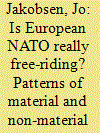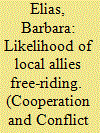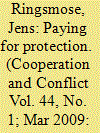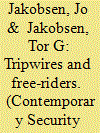|
|
|
Sort Order |
|
|
|
Items / Page
|
|
|
|
|
|
|
| Srl | Item |
| 1 |
ID:
162502


|
|
|
|
|
| Summary/Abstract |
Does European NATO free-ride on America? This article uses a mixed-methods approach to explore developments after the Cold War. I investigate both “material” measures, such as military expenditure and troop numbers, and a “non-material” indicator that draws on survey data of the public’s willingness to fight for their country. Results and conclusions are not univocal. On the one hand, European NATO members have generally reduced their military spending (relative to GDP), abolished conscription and downsized their military forces. Their citizens’ self-reported willingness to fight has also been quite low after the Cold War, in particular in states that host US military bases. On the other hand, some of these developments can surely be explained by a decrease in threat perceptions in Europe. Trends changed markedly after Russia’s 2014 annexation of Crimea, which moved many allies – in particular new NATO member states – to increase their defence efforts.
|
|
|
|
|
|
|
|
|
|
|
|
|
|
|
|
| 2 |
ID:
154731


|
|
|
|
|
| Summary/Abstract |
In counterinsurgency interventions, free-riding by small, local allies is persistent. Yet, the literature on free-riding by small allies is largely limited to conventional multilateral partnerships, such as the North Atlantic Treaty Organization, neglecting other types of asymmetric alliances. Using new data containing 144 US requests to local allies in Vietnam, Iraq and Afghanistan, this article tests the logic of economic theories of alliances in counterinsurgency interventions. I find even when small allies are explicitly asked to contribute to alliance-wide security goods, they are likely to free-ride almost half the time (45%), and the likelihood of free-riding is dependent on whether local allies can be excluded by larger allies. This conclusion upholds the logic of economic models, since shared defense goods that exclude local allies fail to meet the criteria of public goods.
|
|
|
|
|
|
|
|
|
|
|
|
|
|
|
|
| 3 |
ID:
086555


|
|
|
|
|
| Publication |
2009.
|
| Summary/Abstract |
Since the creation of the Atlantic Alliance in 1949, the Alliance's minor partners have persistently spent a smaller share of their Gross Domestic Product (GDP) on military measures than their larger brothers-in-arms do. Taking my cue from collective goods theory, I examine the factors shaping the armament behaviour and military spending patterns of the smaller allies. The article's main theoretical argument is that the smallest among allies tend to perceive their military instruments as the price of admission to a collective defence organization upheld by larger and more potent powers. In essence, military spending becomes the price of security guarantees and protection. Consequently, small allies raise their military expenditures when their security-guaranteeing senior partner threatens with sanctions that the small ally considers more costly than the requested increase in military expenditures and not as a response to rising threats. In the second section of the article, this theoretical claim is illustrated and assessed against Denmark's Cold War defence policies. The empirical findings corroborate the belief that the small allies' leading policy-makers view their armed forces as a necessary evil maintained in order to profit from their senior partners' capabilities.
|
|
|
|
|
|
|
|
|
|
|
|
|
|
|
|
| 4 |
ID:
166609


|
|
|
|
|
| Summary/Abstract |
This article investigates the relationship between U.S. overseas troops and the willingness of the citizens of host states to fight for their country. The study joins the long-running debate about burden-sharing and free-riding among U.S. allies. Unlike most previous empirical studies, we focus on non-material or intangible measures of the underlying concepts. Our dependent variable estimates the proportion of citizens expressing a willingness to fight for their country. Scores at the aggregate-national as well as the individual level are shaped by the presence of U.S. military forces, which act as a “tripwire” signaling credible security commitments. This increases opportunities of (non-material) free-riding. We present both bivariate and multivariate analyses covering the period 1981–2014 to test this supposition. Findings indicate that once U.S. troop levels reach a certain threshold (between 100 and 500 troops), citizens’ willingness to fight drops significantly. This likely reflects non-material free-riding.
|
|
|
|
|
|
|
|
|
|
|
|
|
|
|
|
| 5 |
ID:
145022


|
|
|
|
|
| Summary/Abstract |
It is commonly accepted that peace operations produce public goods. Informed by theories of collective action, the article tests the claim that middle powers were free-riders in NATO’s peace operations in the Balkans (IFOR, SFOR, KFOR) from 1995–2001. In so doing, we charge that calculating the level of defence spending as a share of a country’s GDP, which has become the standard index in the literature, is limiting. We suggest that the active military-duty force share index is a better index to use, and find that middle powers did not free-ride in NATO’s peace operations in the 1990s. Quite to the contrary: they contributed more to NATO’s public good of peacekeeping than countries like France or Germany, and more than expected based on their economic abilities measured in GDP. The article then asks what could be inferred from this analysis, and offers theoretical and methodological points of critique before suggesting new avenues for future research in this vibrant research programme.
|
|
|
|
|
|
|
|
|
|
|
|
|
|
|
|
|
|
|
|
|